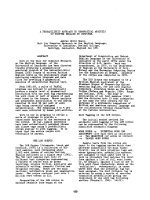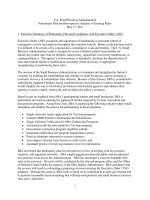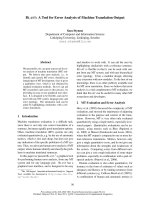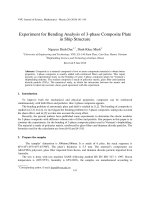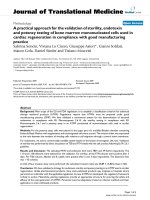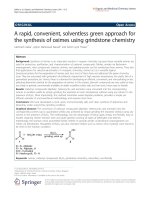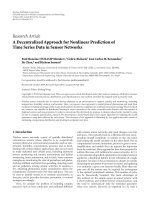ISOGEOMETRIC APPROACH FOR STATIC ANALYSIS OF LAMINATED COMPOSITE PLATES PHƯƠNG PHÁP ĐẲNG HÌNH học CHO PHÂN TÍCH TĨNH tấm COMPOSITE NHIỀU lớp
Bạn đang xem bản rút gọn của tài liệu. Xem và tải ngay bản đầy đủ của tài liệu tại đây (609.05 KB, 11 trang )
Kỷ yếu hội nghị khoa học và công nghệ toàn quốc về cơ khí - Lần thứ IV
ISOGEOMETRIC APPROACH FOR STATIC ANALYSIS OF LAMINATED
COMPOSITE PLATES
PHƯƠNG PHÁP ĐẲNG HÌNH HỌC CHO PHÂN TÍCH TĨNH TẤM COMPOSITE
NHIỀU LỚP
Nguyen Thi Bich Lieu1a, Nguyen Xuan Hung2b
1
HCMC University of Technology and Education, Vietnam
2
Vietnamese-German University, Binh Duong Province, Vietnam
a
;
ABSTRACT
A generalized higher-order shear deformation theory for static analysis of laminated
composite plates using isogeometric analysis (IGA) is presented. The present theory not only
is derived from the classical plate theory (CPT) but also includes the first-order shear
deformation theory (FSDT). The displacement field depends on arbitrary distributed function.
The shear locking phenomenon can be ignored and hence the shear stress free surface
conditions are naturally satisfied. Although it has same number of degrees of freedom as the
FSDT, it does not require shear correction factors. Galerkin weak form of static analysis
model for laminated composite plates is used to obtain the discreted system of equations. It
can be solved by isogeometric approach based on the non-uniform rational B-splines
(NURBS) basic functions. Two numerical examples of the laminated composite plates
including symmetric and non-symmetric with various boundary conditions are presented to
illustrate the effectiveness of the proposed method compared to other methods reported in the
literature.
Keywords: Laminated composite plates, isogeometric analysis (IGA), higher-order
shear deformation theory, NURBS, static analysis.
TÓM TẮT
Một lý thuyết biến dạng cắt tổng quát bậc cao cho phân tích tĩnh tấm composite nhiều
lớp sử dụng phương pháp phân tích đẳng hình học (IGA) được đưa ra. Lý thuyết hiện tại
không chỉ được suy ra từ lý thuyết cổ điển (CPT) mà còn bao gồm lý thuyết biến dạng cắt bậc
nhất (FSDT). Nó được định nghĩa sao cho trường chuyển vị phụ thuộc vào hàm phân bố bất
kỳ. Không có hiện tượng khóa cắt và vì thế điều kiện ứng suất cắt bằng không tự nhiên được
thỏa mãn. Mặc dù lý thuyết đề xuất có cùng bậc tự do với FSDT nhưng nó không yêu cầu hệ
số hiệu chỉnh cắt. Dạng yếu Galerkin của mô hình phân tích tĩnh cho tấm composite nhiều lớp
được sử dụng để đạt được hệ thống các phương trình rời rạc. Nó được giải quyết bằng phương
pháp đẳng hình học dựa trên các hàm cơ sở NURBS. Hai ví dụ số của tấm composite nhiều
lớp bao gồm tấm đối xứng và tấm bất đối xứng với các điều kiện biên khác nhau được đưa ra
để minh họa hiệu quả của phương pháp đề xuất so với các phương pháp khác.
Từ khóa: tấm composite nhiều lớp, phân tích đẳng hình học (IGA), lý thuyết biến dạng
cắt bậc cao, hàm NURBS, phân tích tĩnh.
1. INTRODUCTION
Due to its dominant role in many engineering structures and modern industries,
laminated composite and sandwich plates are widely used in adiverse array of structures in
areas such as aviation, shipbuilding, civil engineering and so on [1]. Therefore, the
development of efficient and reliable mathematical models, deformation theories, and analysis
758
Kỷ yếu hội nghị khoa học và công nghệ toàn quốc về cơ khí - Lần thứ IV
methods to predict the short and long-term behavior of the multilayer composite structures is
extremely important.
A large number of plate theories have been developed to significantly contribute to
advances in computational mechanics of the plate problem. For instance, the classical plate
theory (CPT) [2] is a highly effective means of analyzing of thin plates with no accounting
transverse shear strains. Emergence of the first-order shear deformation theory (FSDT) [3] has
generally been viewed as an improvement over the CPT for both moderately thick and thin
plates which takes shear effect into account. The generalized displacement field in FSDT is
quite simple. However, a shear correction factor (SCF) is required to rectify the unrealistic
shear strain energy component. To overcome the limitations of the FSDT, the higher-order
shear deformation theories (HSDTs) have been then developed. These theories disinterest
SCFs and give more accurate and stable solutions (e.g., inter-laminar stresses and
displacements) than the FSDT ones. These higher-order shear deformation theories include,
third-order shear deformation theory (TSDT) [4], fifth-order shear deformation theory
(FiSDT) [5], trigonometric shear deformation theory (TrSDT) [6], exponential shear
deformation theory (ESDT) [7]and others. The HSDT model requires C1-continuity of
generalized displacement field leading to the second-order derivative of the stiffness
formulation and thus causes difficulties in the standard finite element formulations. In recent
years, C1-continous elements based on mesh free method [8] were proposed to solve the plate
and shell problems. In this paper, we demonstrate that the C1-continuous elements can be
easily achieved by adopting isogeometric analysis without any additional variables.
As we knew, finite element method (FEM) is an efficient computational tool for various
classes of engineering problems and is the reliable choice for solving partial differential
equations in the complex domains. However, it also existssomedis advantages depended on
meshing process. Therefore, Hughes et al.developed a highly effective numerical technique
so called isogeometric analysis (IGA)[9] that is capable of integrating finite element analysis
(FEA) into conventional NURBS-based CAD design tools. Following a decade of
development, isogeometric analysis has surpassed the standard finite elements in terms of
effectiveness and reliability for problems from simple to complex. In IGA, the non-uniform
rational B-splines (NURBS) basis functions are used not only for geometric description but
also for approximation of the displacement field, subsequently allowing us to describe the
curved geometry precisely by using only a few elements and yielding solutions with a higher
accuracy. Some remarkable references for plates can be listed as Kirchhoff plates [10],
Mindlin-Reissner plates [11], plates based on HSDT [12] and plates based on the layer wise
theory [13].
In this paper, a higher-order displacement fields in which displacement field is defined
in general form of distributed functions varying across the plate thickness. The finite element
formulation based on the HSDT requires elements with at least C1-inter-element continuity. It
is difficult to achieve such elements for free-form geometries when using the standard
Lagrangian polynomials as basis functions. However, in IGA can be easily obtained because
NURBS basis functions are Cp-1 continuous. Two numerical examples are provided to
illustrate the effectiveness and reliability of the present method in comparison with other
results from the literature.
759
Kỷ yếu hội nghị khoa học và công nghệ toàn quốc về cơ khí - Lần thứ IV
2. A GENERALIZED HIGHER-ORDER SHEAR DEFORMATION PLATE THEORY
Figure 1. Plate geometry and coordinate system
Let Ω be the domain in R2 occupied by the mid-plane of the plate and u 0 , v 0 , w and β
=(β x ;β y) T denote the displacement components in the x; y; z directions and the rotations in the
x-z and y-z planes (or the-y and the-x axes), respectively. Figure 1 shows the geometry of plate
and coordinate system. A higher-order shear deformation theory derived from the classical
plate theory is defined as follows [14]:
u ( x, y , z , t ) =
u0 ( x, y , t ) − z
v ( x, y , z , t ) =
v0 ( x, y , t ) − z
∂w ( x, y , t )
∂x
∂w ( x, y , t )
∂y
+ f ( z ) β x ( x, y , t )
+ f ( z ) β y ( x, y , t )
w ( x, y , z , t ) = w ( x, y , t )
;
h
−h
≤z≤
2
2
(1)
where f (z) is shape function determining the distribution of the transverse shear strains
and stresses through the thickness of plates. This distributed function is chosen so that
tangential stress-free boundary conditions at the top and bottom surfaces of the plates are
satisfied.
In the present formulation, if distributed function f(z) is chosen to be equal zero, the
higher-order shear deformation theory will take the form of classical plate theory (CPT) (see
in Eq.(2)).
u (=
x , y , z ) u0 ( x , y ) − z
∂w
∂x
h
∂w ; − h
v(=
x, y , z ) v0 ( x, y ) − z
≤z≤
2
∂y 2
(2)
w( x, y , z ) = w ( x, y )
By defining f(z) = z and substituting φ x = −w, x + β x into Eq. (1), the first order shear
deformation theory (FSDT) is obtained as
u (=
x, y , z ) u0 ( x, y ) + zφ x
−h
h
v(=
x, y , z ) v0 ( x, y ) + zφ y ;
≤z≤
2
2
w( x, y , z ) = w ( x, y )
In this paper, we use Eq.(1) with some functions f(z) in Table 1
760
(3)
Kỷ yếu hội nghị khoa học và công nghệ toàn quốc về cơ khí - Lần thứ IV
Table 1:Various forms of shape function and its derivatives
Model
f(z)
Reddy (TSDT)[4]
z−
Arya (TrSDT) [6]
f'(z)
4z2
z
1− 4
h
3h 2
πz
h
π
sin
Karama (ESDT)[7]
ze
Nguyen (FiSDT) [5]
7
z−
2
2
h
8
Thai [14]
−2 z
h
h
2
2
πz
h
cos
z
2
z −2 h
1
−
4
e
h
z +
3
2
h
4
z
5
7
6
−
8
h
2
z +
2
10
h
4
z
2
4
(1 − ( 2 z )2 ) / (1 + ( 2 z )2 )
2
h tan −1 ( z ) − z
h
h
h
The in-plane strain vector ε p is thus expressed by the following equation
ε=
[ε xx ε yy γ xy ]T= ε 0 + zε1 + f ( z )ε 2
p
(4)
and the transverse shear strain vector γ has the following form
γ = γ xz
(5)
T
γ yz =
f ' ( z )ε1s
where f ' ( z ) is derivative of f ( z ) function and
u0, x
ε 0 = v0, y , ε1=
v0, x + u0, y
− w, xx
β x, x
βx
− w, yy , ε 2 = β y , y , ε s = β
y
−2 w, xy
β y, x + β x, y
(6)
By neglecting σ z for each orthotropic layer, the constitutive equation of kth layer in the
local coordinate system derived from Hooke’s law for a plane stress is given by
σ 1k Q
Q12
k 11
σ 2 Q12 Q22
k
0
τ 12 = 0
k 0
0
τ 13
0
τ k 0
23
0
0
Q66
0
0
0
0
0
Q55
Q45
0
0
0
Q54
Q44
k
ε1k
k
ε2
k
γ 12
k
γ 13
γ k
23
(7)
in which reduced stiffness components, Qijk , are expressed by
k
Q11
=
E1k
k
; Q12
=
k
1 − ν 12k ν 21
ν 12k E2k
E2k
k
k
k
k
k
k
k
;
Q
; Q33
=
=
G=
G=
G23
22
12 ; Q55
13 ; Q 44
k
k
1 − ν 12k ν 21
1 − ν 12k ν 21
(8)
where E1 , E2 are the Young’s modulus in the 1 and 2 directions, respectively;
G12 , G13 , G23 are the shear modulus in the 1-2, 3-1, 2-3 planes, respectively and ν ij are the
Poisson’s ratios.
761
Kỷ yếu hội nghị khoa học và công nghệ toàn quốc về cơ khí - Lần thứ IV
The stress - strin relationship in the global reference system (x,y,z) is computed by
k
σ xx
k Q11 Q12
σ yy Q12 Q22
k
τ xy = Q61 Q62
k 0
0
τ xz
k
τ 0
0
yz
0
0
0
0
0
0
Q55 Q54
Q45 Q44
Q16
Q26
Q66
0
0
k
k
ε xx
k
ε yy
k
γ xy
k
γ xz
γ k
yz
(9)
where Qijk is the transformed material constant matrix
A weak form of the static model for the plates under transverse loading q 0 can be
written as
∫ δε
Ω
T
p Dε p dΩ +
D γdΩ ∫ δ wq dΩ
∫ δγ =
(10)
T
s
Ω
0
Ω
where q0 is the transverse loading per unit area and
A B E
D = B D F
E F H
(11)
in which
( Aij , Bij , Dij , Eij , Fij , H ij ) = ∫
h/2
−h/2
( Dsij ) = ∫
h/2
(1, z , z 2 , f ( z ), zf ( z ), f 2 ( z ))Qij dz i, j = 1, 2,6
(12)
2
f ' ( z ) Qij dz i, j = 4,5
−h/2
3. AN ISOGEOMETRIC LAMINATED PLATE FORMULATION
GENERALIZED HIGER-ORDER SHEAR DEFORMATION THEORY
USING
By using the NURBS basis functions defined in [9,14], both the description of the
geometry (or the physical point) and the displacement field u of the plate are approximated as
follows
m× n
m× n
A
A
x h (ξ ,η ) = ∑ RA (ξ ,η )PA and u h (ξ ,η ) = ∑ RA (ξ ,η )q A
(13)
where n×m is the number of basis functions, and xT = ( x y ) is the physical coordinate
vector.
InEq.(13), RA (ξ ,η ) is a rational basic function,
q A = u0 A
v0 A
wA
PA
is the control point and
T
β xA β yA is the vector of nodal degrees of freedom associated with
control point A.
By substituting Eq. (13)with Eq.(4), the in-plane and shear strains can be rewritten as
m× n
ε p γ = ∑ B mA
T
A =1
BbA1 BbA2
T
B sA q A
in which
762
(14)
Kỷ yếu hội nghị khoa học và công nghệ toàn quốc về cơ khí - Lần thứ IV
0 0 − R
0 0
A, xx
B =
0 0 − RA, yy 0 0 ,
0 0 −2 RA, xy 0 0
b1
A
B
b2
A
0 0 0 R
0
A, x
0 R A, y ,
=
0 0 0
0 0 0 RA, y RA, x
R
A, x
0 0 0 RA 0
s
m
,
=
B A =
B
0
A
0 0 0 0 RA
RA, y
0
R A, y
RA, x
0 0 0
0 0 0
0 0 0
(15)
By substituting Eq. (14)with Eq.(10),the formulation of static analysis is obtained in the
following form
Kq = F
(16)
where the global stiffness matrix K is given by
B m T
K ∫ Bb1
=
Ω
Bb 2
m
A B E B
b1
s T s s
B
D
F
B
B
D
B
+
(
)
dΩ
E F H Bb 2
(17)
and the load vector F is calculated as
F
=
∫
Ω
q0 RdΩ
(18)
in which
R = 0 0 RA 0 0
(19)
4. RESULTS AND DISCUSSIONS
This section, due to the limitation of number of pages of the conference, we consider
two examples through a series of benchmark problems for laminated composite plates
including one for symmetric plate and one for anti-symmetric plate.
4.1. Four-layer [00/900/900/00] square laminated plate under a sinusoidally distributed
load
A four-layer fully simply supported square laminated plate subjected to a sinusoidal
πx
πy
pressure defined as q(x, y) = q0 sin( )sin( ) is considered, as shown in Figure 2. All layers
a
b
of the laminated plate are assumed to be of the same thickness and made of the same linearly
elastic composite materials. The length to width ratio is a/b = 1 and the length to thickness
ratios are a/h = 4, 10, 20 and 100, respectively. Material is used
=
E1 25 E2 , G=
G=
0.5 E2 , G=
0.2 E2 ,ν=
0.25.
12
13
23
12
The normalized displacement and stresses are defined as
a a
h2
a a h
h2
a a h
w (100 E2 h3 )=
w( , , 0) / qa 4 ; σ xx =
=
σ
(
,
,
);
σ
σ yy ( , , )
xx
yy
2
2
qa
qa
2 2
2 2 2
2 2 4
=
σ xy
h2
h
h
a
h
a
=
σ xy (0, 0, ); σ xz =
σ xz (0, , 0); σ yz
σ yz ( , 0, 0)
2
qa
qa
qa
2
2
2
763
(20)
Kỷ yếu hội nghị khoa học và công nghệ toàn quốc về cơ khí - Lần thứ IV
Figure 2. Geometry of a laminated plate under a sinusoidally distributed load
Table 2: Normalized displacement and stresses of a simply supported [00/900/900/00]
square laminated plate under a sinusoidally distributed load
a/h Method
w
σ xx
σ yy
σ xy
τ xz
τ yz
4
Exact 3D [15]
1.9540
0.7200
0.6660
0.0467
0.2700
0.2910
IGA-Reddy[4]
1.8936
0.6607
0.6300
0.0440
0.2064
0.2389
IGA-Arya[6]
1.9088
0.6796
0.6332
0.0450
0.2162
0.2462
IGA-Thai[14]
1.9258
0.7164
0.6381
0.0467
0.2396
0.2624
IGA-Soldatos[12]
1.8920
0.6644
0.6316
0.0439
0.2055
0.2382
Exact 3D [15]
0.7430
0.5590
0.4030
0.0276
0.3010
0.1960
IGA-Reddy[4]
0.7147
0.5440
0.3881
0.0267
0.2640
0.1530
IGA-Arya[6]
0.7198
0.5486
0.3905
0.0270
0.2787
0.1588
IGA-Thai[14]
0.7272
0.5552
0.3937
0.0273
0.3133
0.1704
IGA-Soldatos[12]
0.7142
0.5449
0.3881
0.0267
0.2627
0.1526
Exact 3D [15]
0.5170
0.5430
0.3090
0.0230
0.3280
0.1560
IGA-Reddy[4]
0.5060
0.5383
0.3038
0.0228
0.2825
0.1234
IGA-Arya[6]
0.5070
0.5395
0.3090
0.0228
0.2989
0.1272
IGA-Thai[14]
0.5098
0.5412
0.3058
0.0229
0.3372
0.1366
IGA-Soldatos[12]
0.5059
0.5385
0.3038
0.0228
0.2810
0.1231
100 Exact 3D [15]
0.4347
0.5390
0.2710
0.0214
0.3390
0.1410
IGA-Reddy[4]
0.4342
0.5379
0.2704
0.0213
0.2897
0.1116
IGA-Arya[6]
0.4344
0.538
0.2705
0.0213
0.3069
0.1148
IGA-Thai[14]
0.4345
0.538
0.2705
0.0213
0.3467
0.1229
IGA-Soldatos[12]
0.4343
0.5379
0.2704
0.0213
0.2882
0.1114
10
20
764
Kỷ yếu hội nghị khoa học và công nghệ toàn quốc về cơ khí - Lần thứ IV
Figure 3. Comparison of the normalized stress distributions through the thickness of a
four-layer [00/900/900/00] laminated composite square plate (a/h = 4)
Table 2 displays the obtained results using various distributed functions with IGA for
the normalized displacement and stresses. The obtained results including some f(z) functions
of Reddy[4] (IGA-Reddy), Arya [6] (IGA-Arya), Thai et al.[14] (IGA-Thai), Soldatos [12]
(IGA- Soldatos) and the exact 3D elasticity approach of Pagano [15]. According to this table,
IGA conforms well to the exact 3D elasticity solution for all ratios a/h, especially for thick
plates. For a thick plate with a/h = 4 and 10, the IGA-Thai [14] is accurate than other
solutions using IGA. It even moves beyond TSDT by Reddy [4]. Figure 3 plots the
distribution of stresses through the thickness of a four-layer square plate with a/h = 4.
Obviously, obtained results have the similarity with each other.
4.2. Two-layer [00/900] square laminated plate under a sinusoidally distributed load
Let us consider a two-layer (00/900) squareplate subjected to sin load and material as
same above example witha/b = 1; a/h = 10. Three boundary conditions are presented SCSC,
SSSS và SFSF, where S = simply supported, C= clampedand F = free.
765
Kỷ yếu hội nghị khoa học và công nghệ toàn quốc về cơ khí - Lần thứ IV
The normalized displacement is defined as:
w = (100 E2 h3 )
w ( a / 2, a / 2,0 )
qa 4
(21)
Table 3: Normalized displacement w and stresses of a [00/900] square laminated plate
under a sinusoidally distributed load with various boundary conditions
BC
w
σ xx
σ yy
τ xy
τ yz
0.6490
-0.4653
0.3888
0.0221
-
IGA-Reddy[4]
0.6146
-0.4917
0.3778
0.0183
0.1530
IGA-Nguyen[5]
0.5971
-0.5009
0.3733
0.0075
0.1472
IGA-Thai[14]
0.5980
-0.4993
0.3732
0.0076
0.1457
1.2270
-0.7304
0.7309
0.0497
-
IGA-Reddy[4]
1.2161
-0.7446
0.7446
0.0533
0.2837
IGA-Nguyen[5]
1.2044
-0.7492
0.7492
0.0534
0.2766
IGA-Thai[14]
1.2049
-0.7482
0.7482
0.0533
0.2735
2.0260
-0.2503
1.2100
0.0119
-
IGA-Reddy[4]
1.9925
-0.2606
1.2262
0.0098
0.3993
IGA-Nguyen[5]
1.9736
-0.2632
1.2315
0.0032
0.3872
IGA-Thai[14]
1.9744
-0.2626
1.2301
0.0031
0.3829
Method
SCSC AS-Vel[16]
SSSS AS-Vel[16]
SFSF AS-Vel[16]
Figure 4: The normalized stress distributions through the thickness of a two-layer
[00/900] laminated composite square plate (a/h = 10) with IGA-Reddy
766
Kỷ yếu hội nghị khoa học và công nghệ toàn quốc về cơ khí - Lần thứ IV
Table 3 displays the obtained results from IGA-Reddy, IGA-Nguyen and IGA-Thai.
These results are compared with analytical solutions of Vel et al. [16]. It can be seen that the
normalized displacement and stresses are close to those of the analytical solutions for all
various boundary conditions, especially IGA-Reddy solution. Figure 4 illustrates the
normalized stress distributions through the thickness with a/h = 10 using IGA-Reddy for three
differential boundary conditions
5. CONCLUSIONS
This work presents an isogeometric finite element method for static of laminated
composite plates. The results obtained using the generalized higher-order shear deformation
theory showed high reliability and matched well for all test cases from thin to thick plates
when compared with analytical solutions and exact three-dimensional elasticity. As described
in this paper, the distributed function f(z) along the thickness of plate can be easily modified
to obtain the most optimum solution for the targeted engineering problem. The choice of the
distributed function f(z) is still an open question. The authors want to emphasize the higherorder continuity of NURBS basic functions and the flexibility and generality of generalized
displacements when combining IGA with arbitrary distribution functions in this paper.
REFERENCES
[1]
Reddy, J. N, Mechanics of Laminated Composite Plates and Shells Theory and
Analysis. Second edition, CRC Press, New York, 2004.
[2]
Whitney, J. M., The effect of boundary conditions on the response of laminated
composites. Journal of Composite Materials, 1970, Vol. 4, p. 192–203.
[3]
Nguyen-Xuan, H., Rabczuk, T., Nguyen-Thanh, N., Nguyen-Thoi, T.&Bordas, T, A
node-based smoothed finite element method (NS-FEM) for analysis of Reissner–
Mindlin plates. Computational Mechanics, 2010, Vol. 46 p. 679-701.
[4]
Reddy, J.N., A simple higher-order theory for laminated composite plates. Journal of
Applied Mechanics 1984, Vol. 51, p. 745–752.
[5]
H. Nguyen-Xuan, H. C. Thai, and T. Nguyen-Thoi. Isogeometric finite element analysis
of composite sandwich plates using a higher order shear deformation theory. Composite
Part B, 2013, Vol 55, p. 558–574.
[6]
Arya, H., Shimpi, R. P.,& Naik, N. K., A zig-zag model for laminated composite
beams. Composite Structures, 2002, Vol 56, p. 21–24.
[7]
Karama, M., Afaq, K. S.,&Mistou, S., Mechanical behavior of laminated composite
beam by new multi-layered laminated composite structures model with transverse shear
stress continuity. International Journal of Solids and Structures, 2003, Vol. 4 p. 1525–
1546.
[8]
Rabczuk, T., Areias, P. M. A.,& Belytschko, T., A meshfree thin shell method for
nonlinear dynamic fracture. International Journal for Numerical Methods in
Engineering, 2007, Vol. 72, p. 524–548.
[9]
Hughes T.J.R., Cottrell J.A., &Bazilevs Y., Isogeometric analysis: CAD, finite
elements, NURBS, exact geometry and mesh refinement, Computer Methods in Applied
Mechanics and Engineering 2005, Vol. 194, p.4135–95.
[10] Shojae, S., Izadpanah, E., Valizade, N., & Kiendl, J., Free vibration analysis of thin
plates by using a NURBS-based isogeometric approach, Finite Elements in Analysis and
Design, 2012, Vol. 61, p. 23–34
767
Kỷ yếu hội nghị khoa học và công nghệ toàn quốc về cơ khí - Lần thứ IV
[11] Chien, H. T., Nguyen-Xuan, H., Nguyen-Thanh, N., Le, T-H., Nguyen-Thoi, T., &
Rabczuk, T., Static, free vibration, and buckling analysis of laminated composite
Reissner–Mindlin plates using NURBS-based isogeometric approach, International
Journal for Numerical Methods in Engineering, 2012, Vol. 91, p. 571–603
[12] Nguyen-Xuan, H., Thai H.C., &Nguyen-Thoi, T., Isogeometric finite element analysis
of composite sandwich plates using a new higher order shear deformation theory,
Composite part B, 2013,Vol. 55, p. 558-574
[13] Chien, H.T., Ferreira, A.J.M., Carrera, E., &Nguyen-Xuan, H., Isogeometric analysis of
laminated composite and sandwich plates using a layerwise deformation theory,
Composite Structures, 2013, Vol. 104, p.196–214
[14] Thai, H.C., Ferreira, A.J.M., Rabczuk T., Bordas S.P.A., &Nguyen-Xuan, H.,
Isogeometric analysis of laminated composite and sandwich plates using a new inverse
trigonometric shear deformation theory. European Journal of Mechanics - A/Solids
2014, Vol. 43, p. 89-108
[15] Pagano, N.J., Exact solutions for rectangular bidirectional composites and sandwich
plates, Journal of Composite Materials, 1970, Vol. 4, p. 20–34
[16] Vel, S.S., Batra, R.C., Analytical solutions for rectangular thick laminated plates
subjected to arbitrary boundary conditions. American Institute of Aeronautics and
Astronautics Journal 1999, Vol. 37, p. 1464–1473.
AUTHOR’S INFORMATION
1.
Nguyen Thi Bich Lieu, Faculty of Civil and Applied Mechanics, HCMC University of
Technology and Education, , 0938.839.657
2.
Nguyen Xuan Hung, Department of Computational Engineering, Vietnamese-German
University, Binh Duong Province, , 0906.682.393
768


